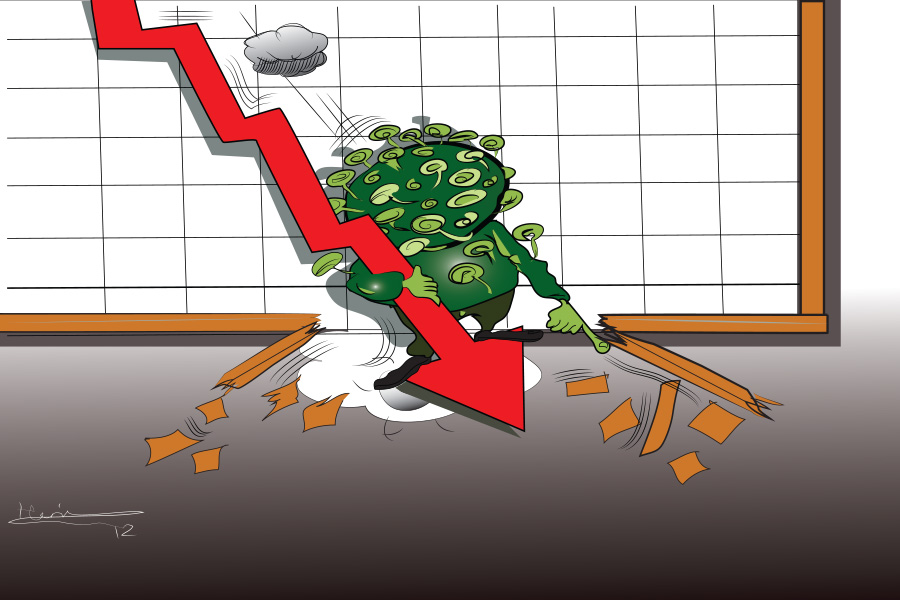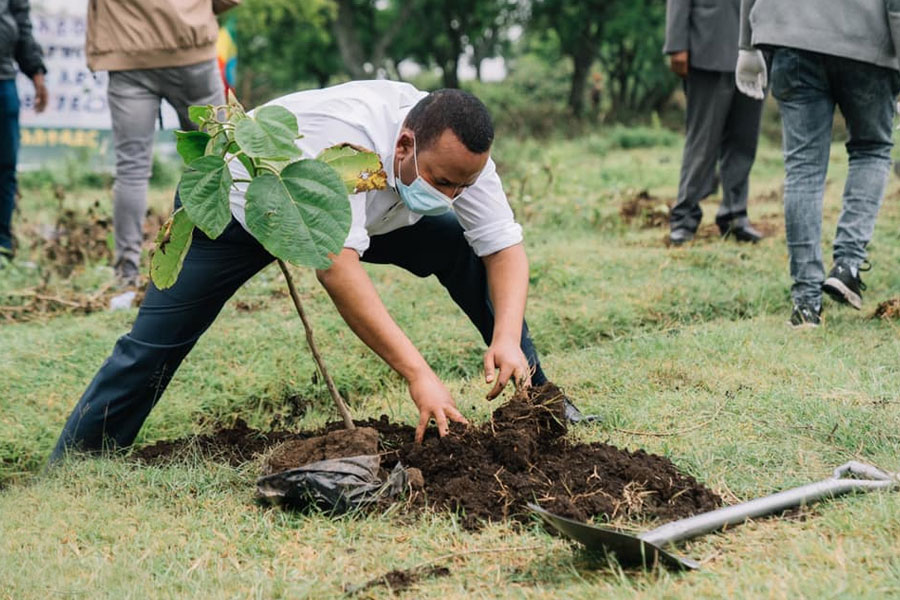
Editorial | Mar 28,2020
Mar 28 , 2020
By Dawit Wondimagegn
The parallels between the Bubonic plague and COVID-19, except in death counts, is uncanny. It depends on Ethiopians' ability to make rational decisions if history is not to be repeated, writes Dawit Wondimagegn (MD) is associate professor of psychiatry at Addis Abeba University’s School of Medicine and chief executive director of Tikur Anbessa Hospital. His views are personal and do not represent the opinion of any institution. He can be reached at dawitwondimagegn@gmail.com.
The Bubonic Plague, also called the Great Dying or Black Death, is the most famous epidemic in Western history. Even though there were reports of plague in earlier centuries, none matched the suffering, horror and scope of the Bubonic Plague. It is said to have travelled from Asia in ships to reach southern Europe in 1348 and continued north to reach Russia by 1351.
The most fascinating aspect of this is the time it took the Plague to spread across Europe - four years - in sharp contrast to Novel Coronavirus Disease 2019 (COVID-19). The latter is a great example of how scientific advancement and technological developments in communication and travel have changed the world for the better while at the same time rendering it vulnerable to epidemics.
The symptoms of this illness were buboes (swollen and oozing nodes), fever, dehydration and death. It sometimes had pneumonic presentation - bubonic lung infection. Its mode of transmission was human-to-human via droplets.
The cause at the time of the Plague was unknown. People hypothesized different causes. Some proposed that it was caused by atmospheric alternations from rare conjunctions of planets. Others saw it as a punishment for the corruption of priests. This actually was credible at the time, as there was a church split over rival popes. Some, of course, blamed the usual scapegoats: strangers, travelers and Jews. The truth was only discovered when the bacteria that caused it was identified in the 1890s.
Death, fever and a lung problems offer remote similarities with COVID-19, but epidemics seem to be in the habit of raising the temperature from the very beginning. The speculation of causes was probably understandable at the time, given the lack of scientific knowledge.
The enigma is that, in our case, we are still in the habit of speculation even if we know what causes COVID-19. At least, the hypothesis that it is a punishment for the corruption of priests over a church split among rival popes is not being considered. However, with the stories that we are hearing about how some of our people treat non-nationals on the streets of Addis Abeba, the habit of blaming travelers, strangers and minorities is well and alive.
Even if there were speculations about the cause, the Plague was unmistakably contagious. Doctors fled cities in large numbers. Those who stayed tried whatever they thought would work, even if many patients did not trust them. They started to use some protective coverings like gowns, gloves and beak-like masks.
As most patients were travelers, states enacted quarantine laws. The word “quarantine” itself comes from this era, a Venetian word for “forty days,” the number of days ships were told not to unload and disembark passengers. There were restrictions on freedom, including travel. If a particular area was found to have the disease, everyone living there was essentially put under house arrest until they died or the disease went away. Though social distancing is a far less drastic approach, quarantines are still how we are combating this disease today.
This probably is where we see a significant correlation between how the Plague is dealt with and how we are dealing with COVID-19. Today, we know exactly how the disease spreads and, thankfully, we have yet to see doctors and other health professionals fleeing cities. But we should not be surprised if we see such a pattern; we already are witnessing some people refusing to provide necessary care for suspected cases out of excessive fear. In our circumstance, where a dire shortage of personal protective devices, such as masks and shields, it will be unfair to judge if some health workers resist their own urge to care. The most important first step that we all should be taking in the early stages of this epidemic, at least in my opinion, is encouraging of health professionals’ motivation and resilience. It is indeed sad to see so many wasted precious masks, gloves and the like on the streets, while hospitals are trying to hold the line to prevent early and unnecessary use of such materials.
We have also witnessed the success of parents urging the interruption of medical training out of fear that their children may catch the disease, effectively teaching their children to flee when they are most needed. In other places and countries, health science students are proving to be a critical back up in the fight against the epidemic. Now, we have unknowingly dismantled our back up line. Those health professionals who will continue to try their best and commit their lives will be serving but may not entirely get the trust of people. For example, the person who escaped from the ambulance he was being transported in. The other important step in early epidemic response is focusing on building trust between each other. Health professionals need to be trusted so they can take care of our people. Our people need to trust that there is no conspiracy here; what they hear is what we hear too; and we all should trust the information that is given to us. There will be time to debate once this is all done and dusted.
Just as doctors during the Plague started to use some protective coverings like gowns, gloves and masks, we are using face shields in the midst of the mania around using personal protective equipment. In fact, I wrote this after a late return from work where I and a colleague witnessed the arrival of professionals to take samples of suspected cases. The first thing they did as they got out of their car in their white personal protective gear was take selfies! It was a nice scene. It was good to see young health professionals trying to capture the moment. So far so good!
The Plague affected up to a third of Europe’s population in the first wave and even more people in subsequent waves. The impact went beyond the loss of human life. There was no one to collect crops from the fields. The resulting famine and illness killed even more. It was said that the death of farmers and lack of farm labour forced the feudal system to collapse, opening up space for an urban middle class to emerge. This was while doctors and priests lost credibility for their apparent lack of control over the Plague.
The most important message we should take from the Plague is that COVID-19 could affect all and kill many, but we have a duty to lessen the suffering and death. COVID-19 will have subsequent waves. We have to be ready for this. Irrespective of how we come out of this pandemic, social dynamics will change as well as our role in society, for better or worse.
It is hard to fail to notice how our agrarian society, only slightly camouflaged by the advancement of science and technology, may be impacted in a similar manner in the instance of an outbreak.
One thing is clear. We must remain calm and do what we can to not allow COVID-19 to become a modern day plague for Ethiopia.
“History repeats itself, first as tragedy, second as farce,” Marx said.
I disagree. History does not repeat itself. We, the people, repeat history. It is within our capacity to not allow ourselves to do so.
When we decide to be guided by unfounded emotions and do not follow the evidence in epidemic control, we repeat history.
PUBLISHED ON
Mar 28,2020 [ VOL
20 , NO
1039]


Editorial | Mar 28,2020

Obituary | Feb 02,2019

Verbatim | Nov 07,2020

View From Arada | Feb 06,2021

Viewpoints | May 24,2025

Commentaries | Oct 20,2024

My Opinion | Apr 26,2019

Fortune News | Mar 11,2023

Fortune News | Nov 09,2019

Fortune News | Oct 08,2022

My Opinion | 131548 Views | Aug 14,2021

My Opinion | 127903 Views | Aug 21,2021

My Opinion | 125879 Views | Sep 10,2021

My Opinion | 123510 Views | Aug 07,2021

Dec 22 , 2024 . By TIZITA SHEWAFERAW
Charged with transforming colossal state-owned enterprises into modern and competitiv...

Aug 18 , 2024 . By AKSAH ITALO
Although predictable Yonas Zerihun's job in the ride-hailing service is not immune to...

Jul 28 , 2024 . By TIZITA SHEWAFERAW
Unhabitual, perhaps too many, Samuel Gebreyohannes, 38, used to occasionally enjoy a couple of beers at breakfast. However, he recently swit...

Jul 13 , 2024 . By AKSAH ITALO
Investors who rely on tractors, trucks, and field vehicles for commuting, transporting commodities, and f...

Jun 28 , 2025
Meseret Damtie, the assertive auditor general, has never been shy about naming names...

Jun 21 , 2025
A well-worn adage says, “Budget is not destiny, but it is direction.” Examining t...

Jun 14 , 2025
Yet again, the Horn of Africa is bracing for trouble. A region already frayed by wars...

Jun 7 , 2025
Few promises shine brighter in Addis Abeba than the pledge of a roof for every family...

Jun 29 , 2025
Addis Abeba's first rains have coincided with a sweeping rise in private school tuition, prompting the city's education...

Jun 29 , 2025 . By BEZAWIT HULUAGER
Central Bank Governor Mamo Mihretu claimed a bold reconfiguration of monetary policy...

Jun 29 , 2025 . By BEZAWIT HULUAGER
The federal government is betting on a sweeping overhaul of the driver licensing regi...

Jun 29 , 2025 . By NAHOM AYELE
Gadaa Bank has listed 1.2 million shares on the Ethiopian Securities Exchange (ESX),...